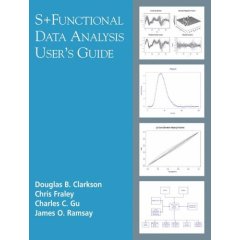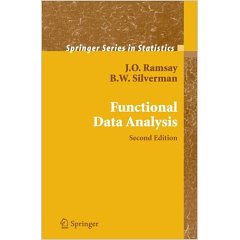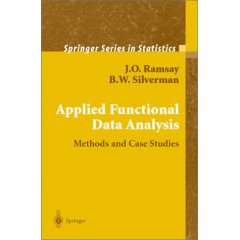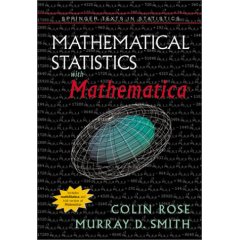« July 2005 | Main | September 2005 »
August 31, 2005
August 30, 2005
Enoch Choi
Enoch Choi thoughts and many many links.
Nicely designed personal log.
And more links.
August 29, 2005
r graphics (Paul Murrell) is out
August 28, 2005
Shanghaiist
August 27, 2005
Non-Gaussian Panel Time Series Model Decomposing Default Risk
We model 1980--2003 rating and cohort specific cumulative default
frequencies. The data is decomposed into systematic and firm-specific
risk components. We have to cope with
(i) the shared exposure of each cohort and rating class to the same
systematic risk factor;
(ii) strongly non-Gaussian features of the individual time series;
(iii) possible dynamics of the unobserved common risk factor;
(iv) changing default probabilities per rating cohort over time
(ageing effects), and
(v) missing observations. We propose a non-Gaussian multivariate state
space model that simultaneously deals with all of this issues.
The model is estimated using importance sampling techniques.
A NON-GAUSSIAN PANEL TIME SERIES MODEL FOR ESTIMATING AND
DECOMPOSING DEFAULT RISK
Session Credit Risk
Field Finance
Session Chair Haibin Zhu, Bank for International Settlements
Presenter(s) Robert J.O. Daniels, De Nederlandsche Bank
Co-Author(s) Andre Lucas, Vrije Universiteit Amsterdam and
Tinbergen Institute and Siem Jan Koopman, Vrije Universiteit Amsterdam
Topics Banking, Empirical Finance, Financial Econometrics and State
Space and Factor Models
Keywords credit risk, importance sampling, multivariate
unobserved components models and non-Gaussian state space models
JEL Codes C32, G21
August 26, 2005
Macroeconomic determinants of the yield curve
Macroeconomic variables besides inflation and real activity drive the
yield curve in the framework of no-arbitrage affine term structure
models. We construct model-based projection of all the latent factors
onto the observable macro factors, which are real activity and
inflation.
As a result, the factors are decomposed into the “macro” part: a
linear function of the macro variables and their lags; and the truly
novel part which is orthogonal to the entire history of the macro
variables. We are able to relate the unexplained part of the short
rate to such measures of liquidity as the AAA credit spread and MZM
growth rate. The unexplained part of the slope is highly correlated
with the budget deficit.
NO-ARBITRAGE MACROECONOMIC DETERMINANTS OF THE YIELD CURVE
Session Term Structure Models
Field Finance
Session Chair Ricardo Brito, Ibmec São Paulo
Presenter(s) Ruslan Bikbov, Columbia Business School
Co-Author(s) Mikhail Chernov, Columbia Business School
Topics Asset Pricing, Empirical Finance, Financial Econometrics and
State Space and Factor Models
Keywords Affine models, Credit Spread, dynamic no-arbitrage
models, Liquidity, Monetary policy, MZM money, Public debt, Taylor
Rules, Term Structure of Interest rates and Vector Auto Regression
JEL Codes E43, E44, G12
August 24, 2005
MCMC method bandwidth selection for multivariate kernel density estimation
Kernel density estimation for multivariate data is an important
technique that has a wide range of applications in econometrics and
finance. The lower level of its use is mainly due to the increased
difficulty in deriving an optimal data-driven bandwidth as the
dimension of data increases. We provide Markov chain Monte Carlo
(MCMC) algorithms for estimating optimal bandwidth matrices for
multivariate kernel density estimation.
Our approach is based on treating the elements of the bandwidth matrix
as parameters whose posterior density can be obtained through the
likelihood cross-validation criterion. Numerical studies for bivariate
data show that the MCMC algorithm generally performs better than the
plug-in algorithm under the Kullback-Leibler information criterion.
Numerical studies for five dimensional data show that our algorithm is
superior to the normal reference rule.
MCMC method bandwidth selection for multivariate kernel density
estimation
Session Nonparametric Estimation II
Field Econometrics
Session Chair Qi Li, Texas A&M University
Presenter(s) Maxwell King, Monash University
Co-Author(s) Xibin Zhang, Department of Econometrics and Business
Statistics, Monash University and Rob Hyndman, Monash University
Topics Semi/Nonparametrics
Keywords Cross-validation, Kullback-Leibler information, Mean
integrated squared errors, Monte Carlo kernel likelihood and Sampling
algorithms
JEL Codes C11, C14, C51
August 23, 2005
Curve Forecasting by Functional Autoregression
This paper explores prediction in time series in which the data is
generated by a curve-valued autoregression process. It develops a
novel technique, the predictive factor decomposition, for estimation
of the autoregression operator, which is designed to be better suited
for prediction purposes than the principal components method.
The technique is based on finding a reduced-rank approximation to the
autoregression operator that minimizes the norm of the expected
prediction error. The new method is illustrated by an analysis of the
dynamics of Eurodollar futures rates term structure. We restrict the
sample to the period of normal growth and find that in this subsample
the predictive factor technique not only outperforms the principal
components method but also performs on par with the best available
prediction methods.
Curve Forecasting by Functional Autoregression
Presenter(s) Alexei Onatski, Columbia University
Co-Author(s) Vladislav Kargin, Cornerstone Research
Session Chair James Stock, Harvard University
Topics Financial Econometrics, Forecasting, State Space and Factor
models and Time Series
Keywords Dimension reduction, Functional data analysis,
Generalized eigenvalue problem, Interest rates, Predictive factors,
Principal components, Reduced-rank regression and Term structure
JEL Codes C23, C53, E43
August 22, 2005
June was Lane Courtesy month
June was Lane Courtesy month.
Keep right except to pass.
Slower traffic keep right.
It's the law.
[Via Motorist News]
August 21, 2005
Efficient Calibration for Libor Market Models
LMM Calibrator Estimation of volatility and correlation parameters in
the sense of (Brigo and Mercurio 2001), (Brigo and Morini 2004) and
(Brigo, Mercurio, and Morini 2005)
- Estimate volatilities from Caps/Floors
- Rescale volatilities to the needed Libor maturity
- Extract correlation parameters from swaption volatilities
Alternative strategies and implementation issues, Thomas Weber, .
August 20, 2005
Functional data analysis (FDA)
Functional data analysis (FDA) handles longitudinal data and treats
each observation as a function of time (or other variable). The
functions are related. The goal is to analyze a sample of functions
instead of a sample of related points.
FDA differs from traditional data analytic techniques in a number of
ways. Functions can be evaluated at any point in their domain.
Derivatives and integrals, which may provide better information (e.g.
graphical) than the original data, are easily computed and used in
multivariate and other functional analytic methods.
S+Functional Data Analysis User's Guide
by Douglas B. Clarkson, Chris Fraley, Charles C. Gu, James O. Ramsay
Functional Data Analysis (Springer Series in Statistics) (Hardcover)
by J. Ramsay, B. W. Silverman
Covers topics of linear models, principal components, canonical
correlation, and principal differential analysis in function spaces.
Applied Functional Data Analysis (Paperback)
by J.O. Ramsay, B.W. Silverman
Bernard W. Silverman's code site Applied Functional Data Analysis: Methods and Case Studies
See also FunctionalData.org, and Function valued traits.
August 19, 2005
Mathematical Statistics with MATHEMATICA
Mathematical Statistics with MATHEMATICA,
Colin Rose, Murray D. Smith (Hardcover)
The mathStatica software, an add-on to Mathematica, provides a
toolset specially designed for doing mathematical statistics. It
enables students to solve difficult problems by removing the technical
calculations often associated with mathematical statistics. The
professional statistician will be able to tackle tricky multivariate
distributions, generating functions, inversion theorems, symbolic
maximum likelihood estimation, unbiased estimation, and the checking
and correcting of textbook formulas. This text would be a useful
companion for researchers and students in statistics, econometrics,
engineering, physics, psychometrics, economics, finance, biometrics,
and the social sciences.
Companion site mathStatica.com
August 18, 2005
Property Grunt ++
Property Grunt is NY-centric and offers charming vignettes
with commentary. Hereby boosted from blogroll 4 to blogroll 2.
August 17, 2005
reowire (real estate owned (REO)) / Paul Jackson
August 16, 2005
Buzz Machine / Jeff Jarvis
Buzz Machine: The wisdom of _People_ and _TV Guide_, combined.
August 15, 2005
Financial Rounds: Academics argue gently
Financial Rounds on how to argue gently *.
See also Suzette Haden Elgin ...
FR visits the FMA and finds another golden oldie: NotN.
The Gentle Art of Verbal Self-Defense at Work (Paperback)
August 14, 2005
Foreign Dispatches
Foreign Dispatches
UK -centric. Examples: 1, 2.
August 13, 2005
NewEconomist
How I Learned to Love Economics (New Economist)
Going on the job market got rid of my self-esteem problem.
There's nothing like explaining why your work is important to a
new captive audience every 30 minutes to make you believe that your
work really is interesting and important.
At some point it dawned on me, I really did want to be a professor.
I can work hours and hours without stopping, so long as I get to
sleep in the next morning. (If only I felt that way about exercise.)
I like being able to choose my own short-term deadlines. I like doing
research. I have important questions to answer and I enjoy the freedom
to work on them.
The process of completing my dissertation has made it much easier
both to come up with new research topics and to figure out, ahead of
time, which projects might be viable. I know which subfields in my
area are understudied. I know what data sets have or don't have the
information I would need to answer those questions. Literature reviews
for new projects bring up questions that beget future work. I have an
agenda.
August 12, 2005
Matthew Yglesias
August 11, 2005
US Housing Bubble
* OFHEO HPI official housing price index.
Another US housing bubble blog.
Mostly links of doom.
* Ben Jones
Patrick Killelea, National and SF.
Another Fucked Borrower is pure gloom, San Diego-centric.
Bubble meter
Ready to burst gives a pop view.
Housing News
housingtracker tracks MLS inventory and quartile prices.
Bubble tracking is mostly statistics, San Diego-centric.
* Housing Panic
Bubbleinfo
boy in the big housing bubble, eg.
Global Economic Analysis / Mike 'Mish' Shedlock
See also
Bill Fleckenstein (Contrarian Chronicles - moneycentral.msn.com)
Dean Baker (CEPR.net)
Jim Puplava (financialsense.com)
local froth and bubbles in housing.
August 10, 2005
lyrics
Cornershop, as explained by Mr GrumpyGus.
There’s Dancing Behind Movie Scenes
behind The Movie Scenes, Sadi Rani
she’s The One That Keeps The Dream Alive
from The Morning Past The Evening
to The End Of The Light
Brimful Of Asha On The 45
well, It’s A Brimful Of Asha On The 45
August 9, 2005
bitchphd
Without parental consent, BitchPhD overcomes depression.
August 8, 2005
edhec-risk hedge fund research
Buy a fund of funds or a hedge fund index ?
Measure risk with more than Sharpe ratio and multi-factor models.
edhec-risk reports research on investment alternatives.
Indexes and benchmarking
Multi-style multi-class risk allocation
Style and Performance analysis.
With very Germanic style:
Unique Access to all Information
Edhec-risk.com offers a unique access to all information appearing in
the different sections and archives. The information is accessed using
a search engine which generates both the key words and the content of
available documents. All the information available on the site is
accessible in relation to the key themes that correspond to the
Centre’s research programmes.
[via Mahobolis]
August 7, 2005
valence
The news media have also become more sensational, more prone to
scandal and possibly less accurate. But note the tension between sensationalism and polarization: the trial of Michael Jackson
got tremendous coverage, displacing a lot of political coverage,
but it had no political valence.
[*]
August 6, 2005
Dan Gillmor
Formerly one of the MSM popular press's better technology writers,
bayosphere's Dan Gillmor didn't stay solo for long.
August 5, 2005
rancor
"If you are an old fan and it doesn't fit what you need, don't buy the
disc." she said with firmness, but no rancor.
[*]
August 4, 2005
Information Visualisation with r
Information Visualisation Lecture Slides uses r.
Sets of lecture slides (PDF), also an 8-up version of the slides suitable for printing.
August 3, 2005
Republican Theme Park

This Republican Theme Park from America is My Girlfriend by Jasik.
August 2, 2005
43folders
43folders for power users and alpha geeks.
Today's tactical equivalent to Seven habits of highly effective people.
August 1, 2005
adroit
Most pro-life voters aren't looking for 'evolving' views among
candidates. They're hungry for principled positions based on immovable
morals - something that doesn't come from a veto and an op-ed.
-- Carrie Gordon Earll, senior policy analyst for bioethics
for Focus on the Family.
Supporters say Mr. Romney is simply being adroit.
[ * ]








